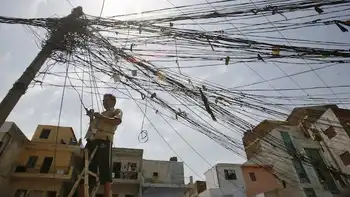Turning trees into power
By Durango Herald
CSA Z463 Electrical Maintenance
Our customized live online or in‑person group training can be delivered to your staff at your location.

- Live Online
- 6 hours Instructor-led
- Group Training Available
J.R. Ford, a real estate man and land manager for out-of-area owners, would turn trees and undergrowth into wood chips to be gasified as fuel to generate electricity. It will work, he told board members of La Plata Electric Association, if they buy his power and the U.S. Forest Service provides stands of timber to harvest.
As a land manager, Ford does fire-fuel mitigation on private property, but he's frustrated with the accumulation of debris that heightens the risk of monstrous wildfire and adversely impacts rebirth of grasses and understory. Now, Ford said, he has found equipment that will allow him to salvage live trees, beetle kills, pine needles, bark and scrub oak.
Swedish firms manufacture the equipment he wants, Ford said. One is a tracked eight-arm machine called a feller buncher that reaches into a stand of timber, cuts trees and snakes them out. Another machine chips them into rounds 1.5 inches in diameter, weighs them and feeds them into a trailer for transportation. At a plant, the chips, under heavy pressure, are converted to a gas to turn a generator.
Greg Munro, CEO of La Plata Electric Association, has been working with Ford on the concept for five years.
“The technology just wasn't there before," Munro said. “But of all the proposals we've heard - particularly as a result of federal stimulus funding - this is the first one that can really happen."
Ford was patient, did his research and has a solid business plan, Munro said.
Not so fast, Steve Hartvigsen, a supervising forester with the Forest Service in Pagosa Springs, said.
Ford's proposal would help the agency meet its forest-health goals, Hartvigsen said. But he is waiting for approval from regional headquarters to offer a “stewardship" contract. Once terms of a contract are set, bidding would be open to all comers, Hartvigsen said. Entrepreneurs with other goals - the production of stove pellets, for example - are interested, he said.
Even his agency's headquarters in Washington could be involved in decisions, Hartvigsen said.
Ford says he is relying on proven technology. A wood-chip gasification project in Canada and a forest thinning project in Arizona are proving successful, Ford said. In order to win backers locally, Ford - as Renewable Forest Energy LLC - will run a demonstration project from May through July on 280 acres in the nearby Turkey Springs area.
If LPEA buys his electricity and the Forest Service gives him a contract to thin timber, his Renewable Forest Energy would build a 5-megawatt power plant along Cloman Boulevard in Pagosa Springs near an LPEA booster station, Ford said.
“This is green energy," Ford said. “In the process of producing energy, we can restore a forest to its 'pre-settlement' look."
A New Mexico man who started a biomass project in 1987 to improve the health of 45 forested acres on his 70-acre ranch near Peñasco wished Ford well.
The treated acres on his Rancho de Jicarito are looking good but it's a labor-intensive process, A. Hart Allex said. He is now on his second pass through wooded areas.
“The equipment he (Ford) is buying is the way to go," Allex said. “But good luck on getting a contract with the Forest Service."
Anti-logging forces, which he blamed for the tinderbox conditions of overgrown forests, are a stumbling block Ford could encounter, Allex said.
Ford intends to press ahead. Thinning forests, he said, reduces the threat of wildfire, improves wildlife habitat, allows more sunlight and moisture to reach the forest floor, promotes understory rebirth, reduces stream pollution and slows the release of methane gas from dead and dying trees.
Production of wood chips from trees generally 5 to 14 inches in diameter would be limited to timber stands within a 50-mile radius of Pagosa Springs, Ford said. Otherwise, the project becomes economically unviable. He estimates that within a 50-mile radius there are 160,000 acres with harvestable ponderosa pine. The power plant would use 40,000 tons of chips from about 2,000 acres a year.
Harvesting would occur six months a year - dependent on weather - with chips being stored at the plant for use in the winter. Ford estimates the project will generate 20 jobs, 14 of them in the power plant.
Ford said he is on solid ground environmentally. Tests have shown the power plant would meet air-quality standards for nearby wilderness areas, he said. Access to timber-harvest areas in the San Juan National Forest and environmental-protection measures would be determined by the Forest Service.
Ford hopes to start building the power plant in July and have it operational by early 2011. If the plant proves successful, Ford wants to establish 10 similar power plants in the Four Corners over five years.











